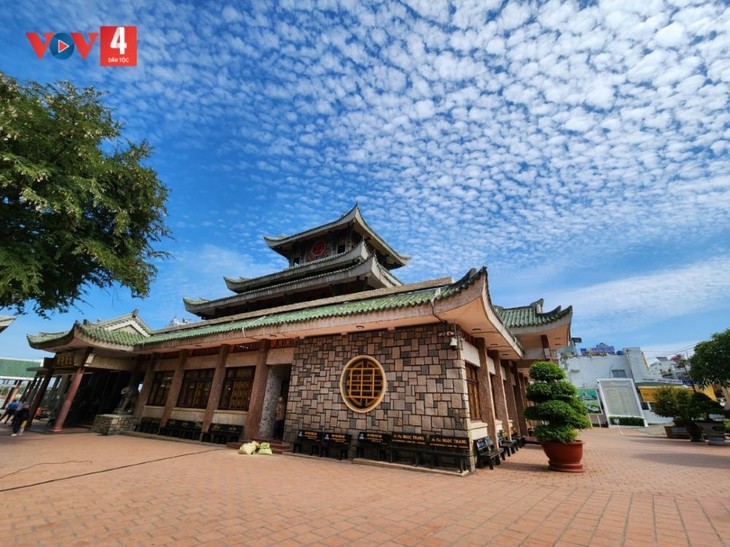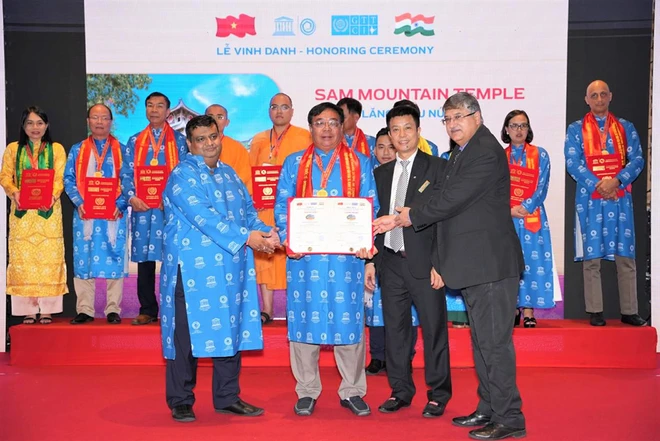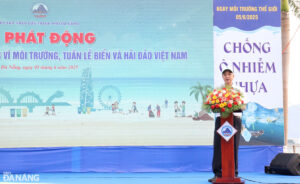The temple of Ba Chua Xu, the Holy Mother of the Realm, is located at the foot of Sam moutain in Chau Doc city, An Giang province. This is a famous spiritual tourism destination in Vietnam’s southwestern region recently recognized by the Vietnam-India Economic and Cultural Exchange Forum as an “Exemplary Asia-Pacific Spiritual Tourism Destination”.

The temple of Ba Chua Xu, the Holy Mother of the Realm, at the foot of Sam moutain in Chau Doc city, An Giang province (Photo: VOV)
The temple leans against Sam Mountain and its main hall faces vast fields. After many restorations, the temple is more spacious and has many artistic features.
Nguyen Phuc Hoan, head of the Management Board of Sam Mountain temple, says the temple’s long history is associated with the folk beliefs of the local people. The temple is associated with Nguyen Van Thoai, also known as Thoai Ngoc Hau, a high-ranking mandarin of the Nguyen Dynasty (1802-1945), who made great contributions to the southern region.
Hoan said: "The Ba Chua Xu temple was built in 1820 when Nguyen Van Thoai, a famous general of King Gia Long, was the appointed governor of Chau Doc. Historical records note that in 1870 the temple underwent a major restoration. In 1962 stone walls and yin and yang roof tiles were added. A gallery was built next to the main temple. In 1972 new architectural features were added to make the temple more harmonious, beautiful, modern, and massive.”
One legend recounts that about 200 years ago people discovered Holy Mother’s statue at the top of Sam mountain and wanted to bring the statue down. Dozens of strong young men tried to carry the statue but couldn’t move it. A female medium said nine virgin girls were needed to carry it. Nine girls were chosen and were able to carry the statue down the mountain, but when they reached the foot of the mountain, they could no longer move it. People decided Holy Mother must have chosen that spot, so they built a temple there to worship her.
Historians say the statue of Ba Chua Xu was carved in the 6th century and is likely an artifact of the ancient Oc Eo culture. In 2009 the statue was inscribed in the An Giang Book of Records as the oldest sandstone statue in Vietnam.

Nguyen Phuc Hoan, head of the Management Board of Sam Mountain Temple receives the certificate recognizing the Ba Chua Xu Temple as an “Exemplary Asia-Pacific Spiritual Tourism Destination” by the Vietnam-India Economic and Cultural Exchange Forum. (Photo: An Giang newspaper)
Tran Minh Trang, a tour guide at the Sam Mountain Tourist Area, said, "Her statue is placed at the center of the main hall. On her right hand is the worship of the two Ladies, and on her left hand is the worship of Thach Chu. In the main hall, there are charming paintings of mountains, rivers, and the iconic flowers of the four seasons – apricot, orchid, chrysanthemum, and bamboo – and statues of the Eight Immortals at the four corners of the room. There are many horizontal paintings and parallel sentences on the walls in praise of Holy Mother’s sacredness. The temple was built with ancient oriental architecture."
Trang said that Sam Mountain is 230 meters high and covers approximately 5 square kilometers. The word ‘Sam’ is the name of an extinct species of marine arthropod called by biologists ‘limuloides’. Scientists believe that this place may once have been under the sea. When the sea receded it became Sam Mountain. One theory is that Sam Mountain is shaped like a limuloides. Another theory is that at one time the mountain was an island surrounded by a sea in which a lot of limuloides lived.
Ba Chua Xu temple has a three-story terraced roof, covered with blue pipe tiles. Each corner of the roof looks like the bow of a boat riding the waves. The interior is decorated with Indian art, particularly the main hall, where statues of strong, beautiful gods stretch their arms up to support the ceiling beams. The frames and doors are intricately carved.
Nguyen Phuc Hoan said, “The temple is in the shape of a square, with a tower in the center like a blooming lotus. The three-story curved roof symbolizes the community connection of the Kinh, Hoa, Khmer, and Cham people. The majestic Lady statue has mascots on both sides, boys on the right and two ladies on the left. The Lady Temple Festival takes place from April 22 to 27 of the lunar calendar.”
The campus of Ba Chua Xu temple is spacious and shaded by tall trees. In the evening, when the lights come on, the ancient temple shines. On a clear day, visitors can view Chau Doc city from the temple’s highest floor.
One visitor said, “I’ve come here twice with my mother and now I’m here with some friends. The Ba Chua temple is very beautiful.”
Every New Year and spring festival, Ba Chua Xu temple attracts a large number of tourists and local visitors. In 2014, the Ministry of Culture, Sports and Tourism recognized the Ba Chua Xu festival as a national intangible cultural heritage.
Lam Thanh - Ngoc Anh
















